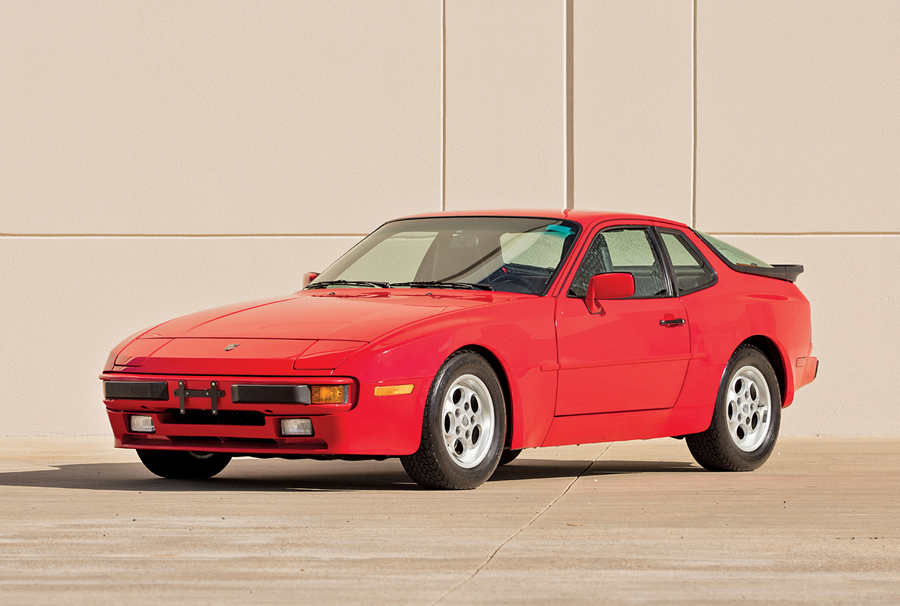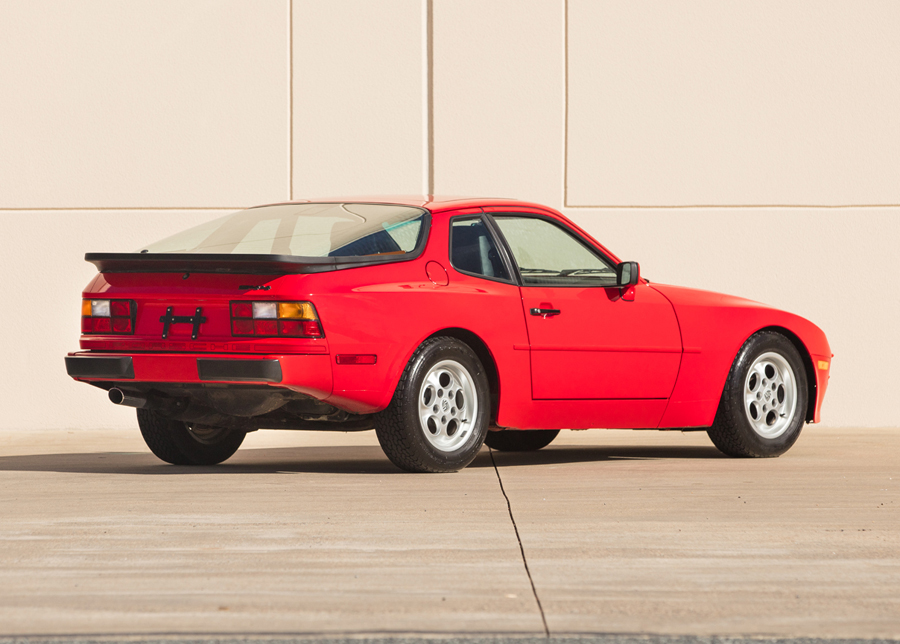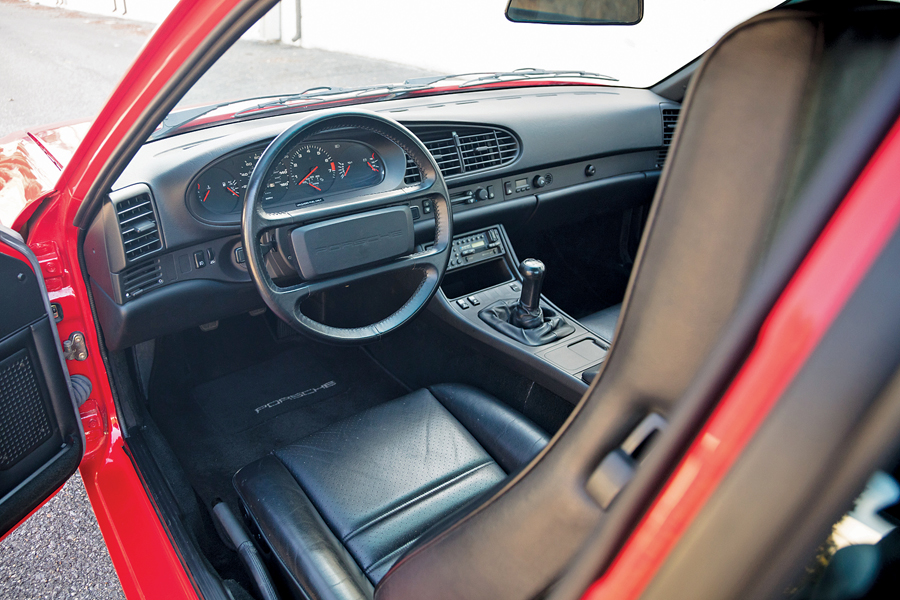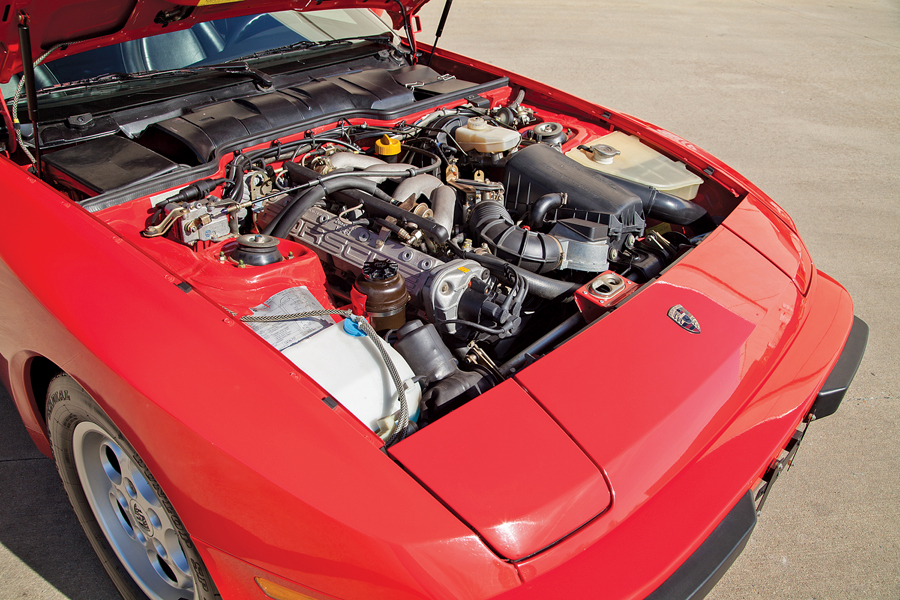- A pristine example with just over 5,100 miles recorded
- Finished in Guards Red over black
- Highly original; museum kept for many years
- One of the finest remaining 944s, complete with books, manuals and original sales paperwork
- A worthy addition to any serious modern Porsche collection
- 2,479-cc inline 4-cylinder engine
- Bosch L-Jetronic fuel injection
- 147 bhp at 6,000 rpm
- 5-speed manual transaxle
- Four-wheel vented disc brakes
SCM Analysis
Detailing
| Vehicle: | 1986 Porsche 944 |
| Years Produced: | 1986 for this car; 1982–91 all 944s |
| Number Produced: | 10,901 in 1986; 140,077 for the entire run |
| Original List Price: | $22,950 |
| SCM Valuation: | $8,500 |
| Tune Up Cost: | $1,000 to $2,000 |
| Chassis Number Location: | Stamping on firewall passenger’s side in front of battery; label on the B pillar; tag at base of windshield driver’s side |
| Engine Number Location: | Driver’s side, at back of engine on bellhousing facing up |
| Club Info: | Porsche Club of America |
| Website: | http://www.pca.org |
| Alternatives: | 1986–91 BMW E30 M3, 1986–92 Mazda RX-7, 1984–89 Nissan 300ZX Turbo |
| Investment Grade: | D |
This car, Lot 7, sold for $41,800, including buyer’s premium, at Gooding & Company’s auction at Amelia Island, FL, on March 9, 2018.
The Porsche 944 was a sensation when it was introduced in Europe in 1982 and in North America in 1983.
I well remember the first 944 to show up at a Porsche Club track day at Lime Rock in the fall of 1982. The owner reported that the car handled like a dream, with almost-even weight distribution (thanks to a rear-mounted transaxle) and precise steering.
The car was underpowered at just 147 horsepower from a 2,479-cc engine for a 2,600-pound car. The car’s good handling, however, made up for the 10% deficit in power-to-weight and kept that 944 on the tail of the PCA (unmodified) track record car of that year, a 1981 SC coupe with a 2,994-cc engine and 180 horsepower for its 2,885 pounds.
That lesson was quickly etched into the brains of the Porsche people who watched.
“Water-cooled” as an almost-mantra
There was a time at Porsche when the 928 and the 924/944 were to be the Porsches of the future. Porsche planned to phase out the archaic 911 with its emissions and safety issues. Happily, Ferry Porsche intervened. Then Peter Schutz (an American), President of Porsche from 1981 to 1987, and Helmuth Bott, executive vice president for research and development, famously saved the 911. Still, the front-engine, water-cooled Porsches had a lot to offer. The 911 owners who dominated the marque’s buyer base simply never embraced those advantages.
Origins in the humble 924
The 924 and 944 were the entry-level Porsches of their day.
The 924, introduced in 1977, was an Audi-based, VW-built car that never really took hold. Its rough, Audi-based engine was frequently likened to a tractor motor. Further, the car’s materials and construction were not Porsche quality.
The 944 and then the 944 Turbo were different stories. These cars were considered true Porsches, with Porsche-designed engines and gearboxes. The engine had two countershafts that completely smoothed out its four cylinders. (Of interest — that system was licensed from Mitsubishi.) The 944 also adopted the muscular fender flares of the 924 Carrera GT and an appropriate Porsche suspension. The model caught on.
Porsche sold over 113,000 944s. That number balloons to over 140,000 cars if you include the follow-up 944 S and 944 S2 models. The United States got 69,400 of those cars.
The 944 models decoded
The introductory 944 was upgraded in mid-1985 with a redesigned dashboard, door panels, uprated suspension pieces, power steering and a larger gas tank.
In 1987, the 944 S debuted with dual overhead cams and 16 valves yielding 190 horsepower. In 1989, the 944 S2’s engine grew to 3 liters and horsepower grew to 208. In addition, anti-lock brakes were installed, and they were big Brembos. For 1992, the 944 model designation was dropped and the substantially revised 968 was introduced to run through the 1995 model year.
After that, Porsche discontinued both the 968 and 928, killing that first generation of water-cooled Porsches.
Need horsepower? Add a turbocharger
In 1986, Porsche added the 944 Turbo with 217 horsepower, which eventually grew to 247 horsepower with the Turbo S that debuted in 1988. Porsche built 25,250 of the 944 Turbos, of which almost 14,000 came to the U.S.
The Playboy/Escort “Showroom Stock” Turbos and the Turbo Cup cars were almost perfect track cars — decontented and lightened, with manual steering racks, no sunroofs and available aftermarket DME/KLR turbo kits that locked down the wastegate and bumped power significantly. My example of that model held the Porsche time trial lap record at Lime Rock for several years in the late 1980s. They were hellaciously good track cars.
The 944 at the Amelia auction
Our subject 1986 944 at Gooding Amelia Island was the updated, second-generation model. Although it was the color of the era, a lot of people now will pay more for any color that is not Guards Red, a hue that wore out its welcome with its prevalence on 944s and 911s of the 1980s. Others say that Guards Red is the era-appropriate color. Buyer’s choice? This example had just 5,100 miles and known one-family ownership until the car went to a museum for 25 years when it was about five years old.
The car was offered recommissioned and running — but on its original Dunlop tires. This car was an excellent original example. It had its tools, manuals and original sales papers.
The final price of $41,800 was low for a bragging-rights Porsche, regardless of the model. I fidgeted with my bidder’s paddle as the car was brought in. There may not be another comparable original, low-miles 944 on the market for years.
No bidding here, but I was happy for the buyer, who got a fine piece of machinery for short money. His next purchase might be a 924 GTS or a 944 Turbo Cup. Then he has a budding collection with a focus.
Your choice for a collectible Porsche water-pumper?
For not a lot more money, let me suggest the 924 GTS that I profiled in SCM’s March 2018 issue (German Profile, p. 72) or even better, the 944 Turbo Cup, a good example of which has been for sale for $65,000 from a New England collector with a barn full of them. (Hmmm — I need to go visit.)
Another substantial collector with over 20 big-money 964/993 supercars, including a GT1, recently purchased a 968 Turbo S. And I am on record saying that the 6-speed 928 GTS is a genuine collectible (June 2016, German Profile, p. 74).
I suspect we will see more collectors putting away front-engine, water-cooled Porsches. This car was well bought. ♦
(Introductory description courtesy of Gooding & Company.)



